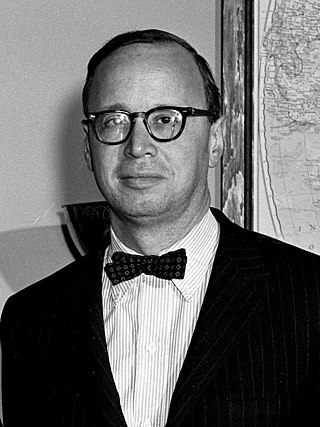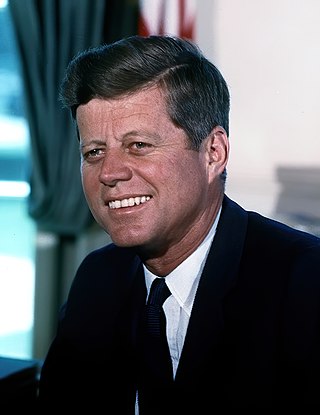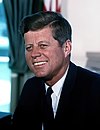
The Kennedy family is an American political family that has long been prominent in American politics, public service, entertainment, and business. In 1884, 35 years after the family's arrival from Ireland, Patrick Joseph "P. J." Kennedy became the first Kennedy elected to public office, serving in the Massachusetts state legislature until 1895. At least one Kennedy family member served in federal elective office from 1947, when P. J. Kennedy's grandson John F. Kennedy became a member of Congress from Massachusetts, until 2011, when Patrick J. Kennedy II retired as a member of the U.S. House of Representatives from Rhode Island.

Arthur Meier Schlesinger Jr. was an American historian, social critic, and public intellectual. The son of the influential historian Arthur M. Schlesinger Sr. and a specialist in American history, much of Schlesinger's work explored the history of 20th-century American liberalism. In particular, his work focused on leaders such as Harry S. Truman, Franklin D. Roosevelt, John F. Kennedy, and Robert F. Kennedy. In the 1952 and 1956 presidential campaigns, he was a primary speechwriter and adviser to the Democratic presidential nominee, Adlai Stevenson II. Schlesinger served as special assistant and "court historian" to President Kennedy from 1961 to 1963. He wrote a detailed account of the Kennedy administration, from the 1960 presidential campaign to the president's state funeral, titled A Thousand Days: John F. Kennedy in the White House, which won the 1966 Pulitzer Prize for Biography or Autobiography.
The United States Revenue Act of 1964, also known as the Tax Reduction Act, was a tax cut act proposed by President John F. Kennedy, passed by the 88th United States Congress, and signed into law by President Lyndon B. Johnson. The act became law on February 26, 1964.

John Fitzgerald Kennedy, often referred to by his initials JFK, was an American politician who served as the 35th president of the United States from 1961 until his assassination in 1963. He was the youngest person to assume the presidency by election and the youngest president at the end of his tenure. Kennedy served at the height of the Cold War, and the majority of his foreign policy concerned relations with the Soviet Union and Cuba. A Democrat, Kennedy represented Massachusetts in both houses of the U.S. Congress prior to his presidency.
Executive Order 11110 was issued by U.S. President John F. Kennedy on June 4, 1963.
The John F. Kennedy assassination and the subsequent conspiracy theories surrounding it have been discussed, referenced, or recreated in popular culture numerous times.

John F. Kennedy's tenure as the 35th president of the United States, began with his inauguration on January 20, 1961, and ended with his assassination on November 22, 1963. A Democrat from Massachusetts, he took office following the 1960 presidential election, in which he narrowly defeated Richard Nixon, the then-incumbent vice president. He was succeeded by Vice President Lyndon B. Johnson.

The inauguration of John F. Kennedy as the 35th president of the United States was held on Friday, January 20, 1961, at the East Portico of the United States Capitol in Washington, D.C. It was the 44th inauguration, marking the commencement of John F. Kennedy's and Lyndon B. Johnson's only term as president and vice president. Kennedy was assassinated 2 years, 306 days into this term, and Johnson succeeded to the presidency.
Barack Obama, a Democrat from Illinois, was elected President of the United States on November 4, 2008 and was inaugurated as the nation's 44th president on January 20, 2009. Re-elected on November 6, 2012, his second inauguration was on January 20, 2013, and his presidency ended on January 20, 2017 with the inauguration of Donald Trump. The following articles cover the timeline of Obama's presidency, and the time leading up to it:
The United States foreign policy during the presidency of John F. Kennedy from 1961 to 1963 included diplomatic and military initiatives in Western Europe, Southeast Asia, and Latin America, all conducted amid considerable Cold War tensions with the Soviet Union and its satellite states in Eastern Europe. Kennedy deployed a new generation of foreign policy experts, dubbed "the best and the brightest". In his inaugural address Kennedy encapsulated his Cold War stance: "Let us never negotiate out of fear. But let us never fear to negotiate".
Bill Clinton, a Democrat from Arkansas, was elected President of the United States on November 3, 1992 and was inaugurated as the nation's 42nd president on January 20, 1993. Re-elected on November 5, 1996, his second inauguration was on January 20, 1997, and his presidency ended on January 20, 2001 with the inauguration of George W. Bush. The following articles cover the timeline of Clinton's presidency, and the time leading up to it:

Donald Trump, a Republican originally from New York, who during his presidency moved his principal residency to Florida, was elected President of the United States on November 8, 2016. He was inaugurated on January 20, 2017 as the nation's 45th president, and his presidency ended on January 20, 2021 with the inauguration of Joe Biden. The following articles cover the timeline of Trump's presidency, and the time leading up to it:
This bibliography of John F. Kennedy is a list of published works about John F. Kennedy, the 35th president of the United States.
The following is a timeline of the presidency of John F. Kennedy from his inauguration as the 35th president of the United States on January 20, 1961, to December 31, 1961.
The following is a timeline of the presidency of John F. Kennedy from January 1, 1963, to November 22, 1963, upon his assassination and death.

Let Us Continue was a speech that 36th President of the United States Lyndon B. Johnson delivered to a joint session of Congress on November 27, 1963, five days after the assassination of his predecessor John F. Kennedy. The almost 25-minute speech is considered one of the most important in his political career.
Wexford, also known as Kennedy Retreat at Rattlesnake Ridge, is a 167-acre (0.67 km2) ranch amid the Blue Ridge Mountains in unincorporated Marshall, Virginia, located 4 miles (6 km) northwest from Middleburg. The property was acquired, designed, and named by Jacqueline Kennedy in 1962 as a weekend retreat during John F. Kennedy's presidency. Its namesake is the ancestral home of the Kennedy family. Following their visit to Wexford (Ireland) in June 1963, Éamon de Valera gifted 3-year old John F. Kennedy Jr. a pony, which was stabled at Wexford (ranch). It is the only home John and Jacqueline built together during their marriage, and was the last place they vacationed before his assassination in November 1963. John Jr. practiced his father's iconic final salute at Wexford.







